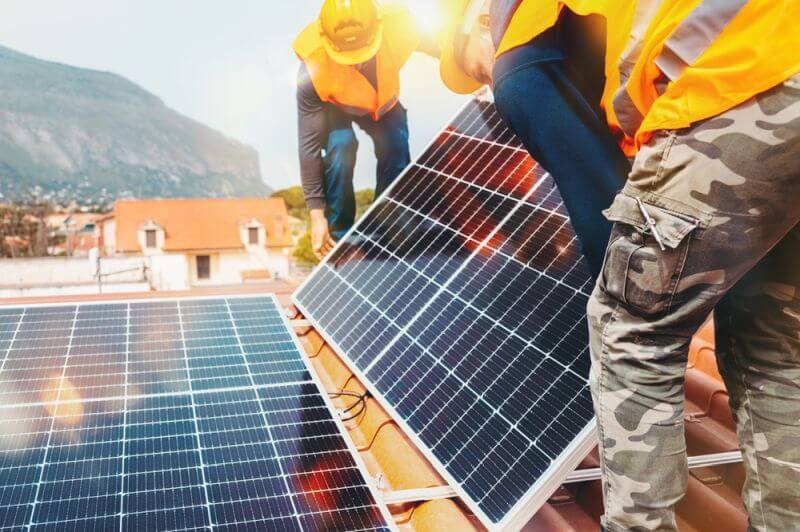Passive solar heating is nothing new. The earliest passive solar heating traces back to Neolithic China, where homes were built with the front facing south, so as to capture the sunlight in wintertime. Our more modern passive solar systems trace their origin back to ancient Rome, where passive solar heat was used in greenhouses and bath houses as early as 300 AD.
The modern push for passive solar heating started in the mid-1970s, but never really took off. While there were some homes built with passive solar heating, their numbers were always low. That is somewhat surprising, considering that only adds about three percent to the cost of a home. At the same time, properly designed passive solar systems will provide more than a third of the home’s heat, paying for themselves quickly.
Surprisingly, few preppers think of passive solar as a means of heating their homes in a time of emergency. That’s probably because they already have homes and retrofitting passive solar onto an existing home is considered ineffective. Homes that rely on passive solar heating are generally designed for passive solar heating.
However, there is always an exception to every rule and there is here as well.
What Makes Up a Passive Solar Heating System?
Before talking about retrofitting a home for passive solar heat, we need to understand how passive solar works. On the simplest level, sunlight coming through your home’s windows strikes something and is absorbed. That absorbed sunlight is converted to heat and then radiated out from whatever was heated by the sunlight. Dark colors absorb more light, so are a more efficient “solar collector” turning that sunlight to heat.
While any home can have a limited amount of this passive solar heating going on, especially if it has south-facing windows, it usually isn’t enough to count as passive solar heating. Put plainly, a large amount of window area, allowing in a lot of sunlight, is necessary for passive solar heat to work.
The components of any passive solar heating system are:
Aperture – These are the windows that the sunlight comes through, so that it can provide the heat. South-facing windows are needed for those of us living in the northern hemisphere. The more windows, the more sun. True passive solar homes will have entire walls of windows.
Control – Something that keeps the sunlight from coming through those windows in the summertime. Properly designed roof eaves do this quite well, as the sun is higher in the sky during the summertime, than it is in the wintertime. So, as long as the eaves stick out far enough, they will block the sunlight from entering the home in the summer, while allowing it to enter during the cooler months.
Absorber – This is something that will absorb the sunlight and convert it to heat. Most of the time it is the floor; but a stone wall, placed just inside the windows can be used as well. Ideally, the absorber should be black, so that it will absorb the most sunlight, producing the most heat. If it can’t be black, then it should be as dark as possible.
Thermal Mass – This can be thought of as a “heat battery,” holding the heat generated by the absorber and storing it until it is needed. Heat is radiated out from the thermal mass, whenever the ambient temperature in the home is cooler than the temperature of the thermal mass. Generally speaking, it releases more heat at night, than it does in the daytime. A thick stone or concrete floor, with the absorber attached to it as the flooring, makes an excellent thermal mass.
Using that Heat
The heat generated by any passive solar system needs to be released into the home automatically, without any sort of sensors, blowers or controls. This is most often accomplished by simply allowing the heat to radiate from the thermal mass into the home. Taking that a step further, we all know that heat rises, so once the heat has been radiated into the room, it will start rising, heating rooms on the upper floor. Two-story homes, which are designed to be passive solar homes, often have a partial second story, like a balcony, allowing the heat to rise and then enter the rooms. This movement of heat is called “convection.”
The only problem with this is there is no control over how quickly or how much heat is released by the system. Control of the temperature requires controlling the sunlight coming into the home or allowing cool air into the home, through windows, to mix with the warm air.
Adding Passive Solar Heat to a Home
Adding passive solar heat to a home is generally considered impossible by the purists who design passive solar homes. That’s largely due to the cost of retrofitting and the fact that non-passive solar homes aren’t built in a way to allow the heat to naturally circulate by convection. However, how impossible it is or isn’t depends largely on just how much heat we want to generate from the sun and how much the homeowner is willing to spend to gain the solar advantage.
The first way of adding passive solar to a home is to put in a lot of windows on the south-facing side. While this will provide more sunlight in the home, generating more heat, it doesn’t have the advantage of a thermal mass storing that heat. Adding a thermal mass under these circumstances is generally thought to be impractical. There is also the problem of a control; but that problem can be solved with the judicious use of shades over the windows.
Nevertheless, a second option exists; one that will be much more effective and practical. That is to add a sun room onto the south side of the home. Sun rooms, if you haven’t seen one, are like an enclosed patio, except that the roof and walls are made entirely of windows, with only enough wood structure to hold everything together. If a sun room were built, with say a black flagstone floor, over several inches of concrete, it would make an effective passive solar heater. As mentioned a moment ago, shades can be added on the inside of the windows, to control the sunlight coming in.
Getting that Heat Into the Home
The biggest problem with using a sunroom as a passive solar heating source, is getting the heat from the sunroom into the main part of the house. There are a couple of ways to go about this, keeping in mind that the main means of moving that heat needs to be convection, rather than using fans or something else that would require electricity.
Obviously, the bigger the opening between the sunroom and the rest of the house, the more heat could naturally move from the sunroom into the house. Say, for example, that the sunroom is being attached to the side of the house where the family room is. In that case, removing 10 or 12 feet of the exterior wall, making a wide entrance between the sunroom and the family room, would work well to help the heat move into the house.
If the south-facing side of your home is a couple of steps higher than the land around it, so much the better. In that case, the concrete slab for the thermal mass can be poured so that its surface is only a few inches above the ground. The highest point of the sunroom’s roof could then align with the ceiling of the adjoining room, allowing warm air to move from the sun room into the house. That would push cooler air, down near the floor, into the sunroom, where it could be warmed.
In cases where that option doesn’t work, but where the home has two stories, the roof of the sunroom can butt into the wall of the home, a couple of feet above the second-story floor. Vents cut in the wall would then allow warm air from the sunroom to rise into the second-story bedrooms, heating them. As that air cooled, it would flow back down to the first floor, where it could repeat the cycle.
Of course, movement of this air could be helped with fans; but that’s not something we can count on during a time of crisis. If the power is out, we wouldn’t want to be using whatever limited electricity we had available to run fans. Better to design and install a system that will operate on its own, totally passively.
Will This Be Enough?
Don’t think that adding a sunroom will provide all the heat that your family will need. It won’t. However, it will provide some heat. Every bit of heat that you can get from passive solar, is that much less heat that you have to generate from a fireplace or wood-burning stove. Used in conjunction with those other heating systems, it can save you fuel and keep your home warmer.
Not only that, but if you build your sun room so that the warm air from it is feeding into the upstairs bedrooms, it will help to keep them warmer. In most homes, the fireplace or wood-burning stove won’t heat those upper-story rooms; so that will give you an advantage you wouldn’t otherwise have.










John | September 15, 2024
|
AS long as there is not a nuke winter, this sounds good. Not for me, but someone building a BOL now, it might be worth it to have a passive system. That IMO.